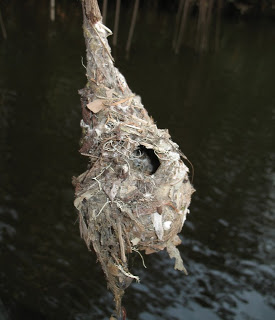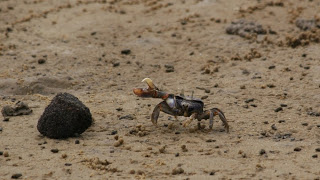Last Peninsula trip, for now
On Thursday afternoon Joao and I boated back over to the Sereia peninsula to do a few more interviews at villages. We took along Mendez and Gisela, the Angolan students, and showed them the habitat around Pululu Channel (which is more like a small lagoon than a channel) and another gorgeous channel where there are enormous mangrove trees. Mendez told me there are 3 species of mangrove in Angola, 2 that are saltwater and one that can live in freshwater. We interviewed the soba (chief) at Pululu village who gave us another report of seeing manatees in the area as frequently as several times a month, but he said there were more in the area in a long time ago.
 This man collecting firewood and his canoe gives some perspective to show just how gigantic the mangroves are.
This man collecting firewood and his canoe gives some perspective to show just how gigantic the mangroves are. We also saw a group of Moustached Guenons as we toured the mangroves. They were pretty curious and this one came down to eye level to check us out. A few minutes later they evaporated into the forest.
We also saw a group of Moustached Guenons as we toured the mangroves. They were pretty curious and this one came down to eye level to check us out. A few minutes later they evaporated into the forest. 
 We also stopped at a village called Moita Seca II at the end of a large channel (I hadn’t been there yet) and spoke to a man who said manatees rarely come there now, but he had seen one this past June and he pointed out a small river nearby where they were sighted more frequently. The river has a lot of fallen logs, so only non-motorized boats can navigate it. He also proudly told us that the manatee hunter had come by there a few years ago, and their village told him to go away because they didn’t want him to kill their manatees. This was not altruism towards the manatees, but rather the village felt the manatees were theirs and if anyone was going to kill them, it should be them. However, they didn’t hunt manatees, so it was actually a form of protection. The man also told us they knew manatees only had one calf every year or two. When I asked him how he knew this, he said that many years ago a pregnant female had been killed at Pululu (several villages away) and they had seen that it had only one large fetus. They assumed that like other large animals they know (hippos, etc.) manatees must reproduce slowly.
We also stopped at a village called Moita Seca II at the end of a large channel (I hadn’t been there yet) and spoke to a man who said manatees rarely come there now, but he had seen one this past June and he pointed out a small river nearby where they were sighted more frequently. The river has a lot of fallen logs, so only non-motorized boats can navigate it. He also proudly told us that the manatee hunter had come by there a few years ago, and their village told him to go away because they didn’t want him to kill their manatees. This was not altruism towards the manatees, but rather the village felt the manatees were theirs and if anyone was going to kill them, it should be them. However, they didn’t hunt manatees, so it was actually a form of protection. The man also told us they knew manatees only had one calf every year or two. When I asked him how he knew this, he said that many years ago a pregnant female had been killed at Pululu (several villages away) and they had seen that it had only one large fetus. They assumed that like other large animals they know (hippos, etc.) manatees must reproduce slowly.A Fiddler Crab waving his claw A Common Whimbrel enjoys solitude on a mudflat in Pululu Channel
A Common Whimbrel enjoys solitude on a mudflat in Pululu Channel


guenon, not mangabey